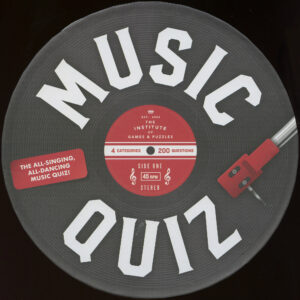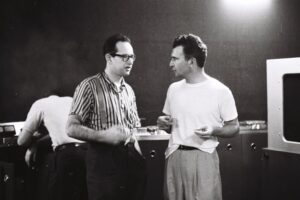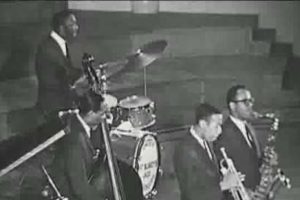“Trane & Miles” focuses on the making of “Kind of Blue,” which is the best-selling jazz album of all time. It was recorded in two sessions during the spring of 1959 and released in August of that year. Besides Coltrane and Davis, personnel are Cannonball Adderley (sax), Wynton Kelly and Bill Evans (piano), Paul Chambers (bass) and Jimmy Cobb (drums). Click here or on the image for more on the record, which has been called one of the most important in jazz history.
 “Trane & Miles” focuses on the making of “Kind of Blue,” which is the best-selling jazz album of all time. It was recorded in two sessions during the spring of 1959 and released in August of that year. Besides Coltrane and Davis, personnel are Cannonball Adderley (sax), Wynton Kelly and Bill Evans (piano), Paul Chambers (bass) and Jimmy Cobb (drums). Click here (iTunes) or on the image (Amazon) for more on the record, which has been called one of the most important in jazz history.
“Trane & Miles” focuses on the making of “Kind of Blue,” which is the best-selling jazz album of all time. It was recorded in two sessions during the spring of 1959 and released in August of that year. Besides Coltrane and Davis, personnel are Cannonball Adderley (sax), Wynton Kelly and Bill Evans (piano), Paul Chambers (bass) and Jimmy Cobb (drums). Click here (iTunes) or on the image (Amazon) for more on the record, which has been called one of the most important in jazz history. Broadway World had an item on Monday on a short film, Trane and Miles, that chronicles the making of Kind of Blue, which the story says is the best-selling album in jazz history. A trailer for the film is below, and there is more information at the site. Above is So What (with, according to a note a YouTube, Paul Chambers of Contrabass, Wynton Kelly on piano and Philly Joe Jones on drums).
“Trane & Miles” focuses on the making of “Kind of Blue,” which is the best-selling jazz album of all time. It was recorded in two sessions during the spring of 1959 and released in August of that year. Besides Coltrane and Davis, personnel are Cannonball Adderley (sax), Wynton Kelly and Bill Evans (piano), Paul Chambers (bass) and Jimmy Cobb (drums). Click here or on the image for more on the record, which has been called one of the most important in jazz history. [/mks_pullquote]The relationship between John Coltrane and Miles Davis is an important one in jazz history. It has been written about in many places. I don’t have the background to assess it myself, but can point to some good resources.
For instance, the blog Elsewhere featured a post by Graham Reid entitled John Coltrane and Miles Davis: Genius at Work and Playing, 1955-1961. Reid offers insight into the interesting back story on how the two hooked up. Somehow, it all worked out:
Davis – at 29 and four months the saxophonist’s senior – had rarely seen Coltrane play and, on the few occasions he had, was unimpressed. Yet, perhaps desperate as the recording date approached, he made the call. Coltrane joined Davis’ band only a month before its Columbia recording debut on October 26, 1955.
It was an occasionally volatile relationship with Coltrane twice leaving and being replaced by Rollins. Yet the music made for Columbia by the Davis-led line-ups – Round About Midnight, Milestones and, in particular, Kind of Blue – defined an intellectual style of jazz others could only attempt to emulate.
A few years ago, Ben Leubner reviewed a book entitled Clawing the Limits of Cool by Farrah Jasmine Griffin and Salim Washington at the site Critical Studies in Improvisation. As usual in these cases, the review is more about the subject than the book, per se. Leubner writes:
The trumpeter and the saxophonist complemented each other perfectly precisely because they were completely different from one another, a dynamic which Griffin and Washington explore at great length. Davis, in his life, was extroverted, intense, even violent. In his playing, though, he was cool, humble, reticent. Coltrane, in his life, was cool, humble, and reticent, while his playing was extroverted, intense, and violent, or, to use a favorite word of Coltrane critics during the late 1950s, “angry.” In a 1960 interview with Coltrane (during his last tour with Davis, a European jaunt), Swedish radio host Karl-Erik Lindgren assumes that because “the playing mirrors the personality,” Coltrane must have an angry demeanor, or at least angry thoughts on his mind. When asked if he feels angry, though, Coltrane replies calmly, “No, I don’t” (Davis). Perhaps the playing does mirror the personality, but in the sense of reversing it, not in the sense of replicating it exactly. This, at least, seems to be the case with both Davis and Coltrane during the years of their collaboration.
The third piece I found on the relationship between Coltrane and Davis is a long one at Tripod. Brian Knight covers a lot of ground, including a nice explanation of why Davis simply sounded different than other trumpeters – it’s sometimes hard to remember that he was playing the same instrument as Louis Armstrong or Red Allen:
What made Miles Davis stand out and truly becomes a jazz music icon was more than his compositions, it was his unique playing style. In comparison to other great trumpeters such as Dizzy Gillepsie, Davis mastered the lower register of the trumpet’s sounds and preferred to play at a much slower tempo which made moodier, more contemplative pieces of music. The key ingredient to creating this mood pieces was Davis’ use of the Harmon mute. Coupled with the economical use of notes and phrasings through which Davis tried not to overwhelm a composition with excessive notes, Davis created a unique playing style that would influence generations of musicians to come. In contrast, John Coltrane preferred a faster tempo and he attempted to bombard the listener with notes. As Miles Davis was economical, Coltrane used his notes like a child with a ten-dollar bill in a penny candy shop.
There are, of course, many other posts and articles about the collaboration of the two giants. These three – and the short film, which was directed by Scott Essman – are good places to start.










